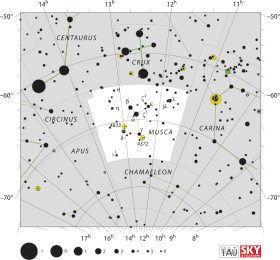Gamma Muscae
γ Muscae, Latinised as Gamma Muscae, is a blue-white hued star in the southern circumpolar constellation of Musca, the Fly. It can be seen with the naked eye, having an apparent visual magnitude of 3.87.[2] Based upon an annual parallax shift of 10.04 mas as seen from Earth, it is located about 325 light years from the Sun.
 | |
| Observation data Epoch J2000.0 Equinox J2000.0 | |
|---|---|
| Constellation | Musca |
| Right ascension | 12h 32m 28.01343s[1] |
| Declination | −72° 07′ 58.7597″[1] |
| Apparent magnitude (V) | 3.87[2] |
| Characteristics | |
| Spectral type | B5 V[3] |
| U−B color index | −0.61[2] |
| B−V color index | −0.15[2] |
| Variable type | SPB |
| Astrometry | |
| Radial velocity (Rv) | 2.5±7.4[4] km/s |
| Proper motion (μ) | RA: −51.34[1] mas/yr Dec.: −5.40[1] mas/yr |
| Parallax (π) | 10.04 ± 0.13[1] mas |
| Distance | 325 ± 4 ly (100 ± 1 pc) |
| Absolute magnitude (MV) | –1.1[5] |
| Details | |
| Radius | 4.24[6] R☉ |
| Luminosity | 790[5] L☉ |
| Surface gravity (log g) | 4.04[5] cgs |
| Temperature | 16,000[5] K |
| Rotational velocity (v sin i) | 205[3] km/s |
| Other designations | |
| Database references | |
| SIMBAD | data |
This is a B-type main-sequence star with a stellar classification of B5 V.[3] It is a variable star that ranges between magnitudes 3.84 and 3.86 over a period of 2.7 days, and is classed as a slowly pulsating B star.[7] It is around five times as massive as the Sun.[8] The star is spinning rapidly with a projected rotational velocity of 205 km/s. This is giving it an oblate shape with an equatorial bulge that is 7% larger than the polar radius.[3]
Gamma Muscae is a proper motion member of the Lower-Centaurus Crux sub-group in the Scorpius-Centaurus OB association, the nearest such association of co-moving massive stars to the Sun.[5]
References
- van Leeuwen, F. (November 2007), "Validation of the new Hipparcos reduction", Astronomy and Astrophysics, 474 (2): 653–664, arXiv:0708.1752, Bibcode:2007A&A...474..653V, doi:10.1051/0004-6361:20078357.
- Johnson, H. L.; et al. (1966), "UBVRIJKL photometry of the bright stars", Communications of the Lunar and Planetary Laboratory, 4 (99), Bibcode:1966CoLPL...4...99J.
- van Belle, Gerard T. (March 2012), "Interferometric observations of rapidly rotating stars", The Astronomy and Astrophysics Review, 20 (1): 51, arXiv:1204.2572, Bibcode:2012A&ARv..20...51V, doi:10.1007/s00159-012-0051-2.
- Gontcharov, G. A. (November 2006), "Pulkovo Compilation of Radial Velocities for 35495 Hipparcos stars in a common system", Astronomy Letters, 32 (11): 759–771, arXiv:1606.08053, Bibcode:2006AstL...32..759G, doi:10.1134/S1063773706110065.
- de Geus, E. J.; et al. (June 1989), "Physical parameters of stars in the Scorpio-Centaurus OB association", Astronomy and Astrophysics, 216 (1–2): 44–61, Bibcode:1989A&A...216...44D.
- Shulyak, D.; et al. (2014), "Interferometry of chemically peculiar stars: Theoretical predictions versus modern observing facilities", Monthly Notices of the Royal Astronomical Society, 443 (2): 1629, arXiv:1406.6093, Bibcode:2014MNRAS.443.1629S, doi:10.1093/mnras/stu1259.
- BSJ (5 March 2012). "Gamma Muscae". AAVSO Website. American Association of Variable Star Observers. Retrieved 21 December 2013.
- Molenda-Zakowicz, J.; Połubek, G. (2004). "Empirical absolute magnitudes, luminosities and effective temperatures of SPB variables and the problem of variability classification of monoperiodic stars" (PDF). Acta Astronomica. 54: 281–97 [283]. Bibcode:2004AcA....54..281M.